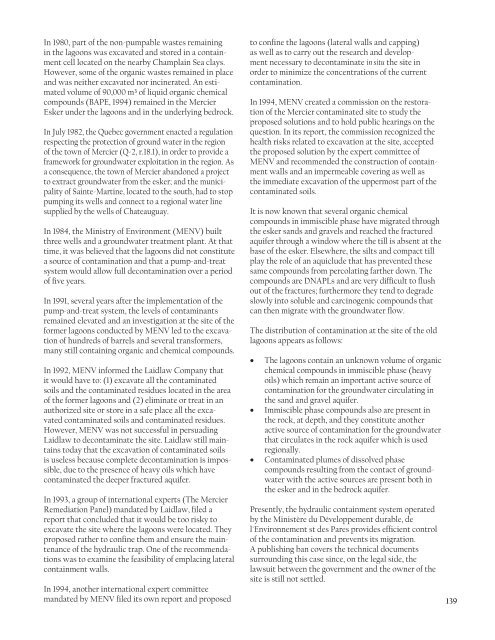Groundwater in the Great Lakes Basin
Groundwater in the Great Lakes Basin
Groundwater in the Great Lakes Basin
You also want an ePaper? Increase the reach of your titles
YUMPU automatically turns print PDFs into web optimized ePapers that Google loves.
In 1980, part of <strong>the</strong> non-pumpable wastes rema<strong>in</strong><strong>in</strong>g<br />
<strong>in</strong> <strong>the</strong> lagoons was excavated and stored <strong>in</strong> a conta<strong>in</strong>ment<br />
cell located on <strong>the</strong> nearby Champla<strong>in</strong> Sea clays.<br />
However, some of <strong>the</strong> organic wastes rema<strong>in</strong>ed <strong>in</strong> place<br />
and was nei<strong>the</strong>r excavated nor <strong>in</strong>c<strong>in</strong>erated. An estimated<br />
volume of 90,000 m³ of liquid organic chemical<br />
compounds (BAPE, 1994) rema<strong>in</strong>ed <strong>in</strong> <strong>the</strong> Mercier<br />
Esker under <strong>the</strong> lagoons and <strong>in</strong> <strong>the</strong> underly<strong>in</strong>g bedrock.<br />
In July 1982, <strong>the</strong> Quebec government enacted a regulation<br />
respect<strong>in</strong>g <strong>the</strong> protection of ground water <strong>in</strong> <strong>the</strong> region<br />
of <strong>the</strong> town of Mercier (Q-2, r.18.1), <strong>in</strong> order to provide a<br />
framework for groundwater exploitation <strong>in</strong> <strong>the</strong> region. As<br />
a consequence, <strong>the</strong> town of Mercier abandoned a project<br />
to extract groundwater from <strong>the</strong> esker; and <strong>the</strong> municipality<br />
of Sa<strong>in</strong>te-Mart<strong>in</strong>e, located to <strong>the</strong> south, had to stop<br />
pump<strong>in</strong>g its wells and connect to a regional water l<strong>in</strong>e<br />
supplied by <strong>the</strong> wells of Chateauguay.<br />
In 1984, <strong>the</strong> M<strong>in</strong>istry of Environment (MENV) built<br />
three wells and a groundwater treatment plant. At that<br />
time, it was believed that <strong>the</strong> lagoons did not constitute<br />
a source of contam<strong>in</strong>ation and that a pump-and-treat<br />
system would allow full decontam<strong>in</strong>ation over a period<br />
of five years.<br />
In 1991, several years after <strong>the</strong> implementation of <strong>the</strong><br />
pump-and-treat system, <strong>the</strong> levels of contam<strong>in</strong>ants<br />
rema<strong>in</strong>ed elevated and an <strong>in</strong>vestigation at <strong>the</strong> site of <strong>the</strong><br />
former lagoons conducted by MENV led to <strong>the</strong> excavation<br />
of hundreds of barrels and several transformers,<br />
many still conta<strong>in</strong><strong>in</strong>g organic and chemical compounds.<br />
In 1992, MENV <strong>in</strong>formed <strong>the</strong> Laidlaw Company that<br />
it would have to: (1) excavate all <strong>the</strong> contam<strong>in</strong>ated<br />
soils and <strong>the</strong> contam<strong>in</strong>ated residues located <strong>in</strong> <strong>the</strong> area<br />
of <strong>the</strong> former lagoons and (2) elim<strong>in</strong>ate or treat <strong>in</strong> an<br />
authorized site or store <strong>in</strong> a safe place all <strong>the</strong> excavated<br />
contam<strong>in</strong>ated soils and contam<strong>in</strong>ated residues.<br />
However, MENV was not successful <strong>in</strong> persuad<strong>in</strong>g<br />
Laidlaw to decontam<strong>in</strong>ate <strong>the</strong> site. Laidlaw still ma<strong>in</strong>ta<strong>in</strong>s<br />
today that <strong>the</strong> excavation of contam<strong>in</strong>ated soils<br />
is useless because complete decontam<strong>in</strong>ation is impossible,<br />
due to <strong>the</strong> presence of heavy oils which have<br />
contam<strong>in</strong>ated <strong>the</strong> deeper fractured aquifer.<br />
In 1993, a group of <strong>in</strong>ternational experts (The Mercier<br />
Remediation Panel) mandated by Laidlaw, filed a<br />
report that concluded that it would be too risky to<br />
excavate <strong>the</strong> site where <strong>the</strong> lagoons were located. They<br />
proposed ra<strong>the</strong>r to conf<strong>in</strong>e <strong>the</strong>m and ensure <strong>the</strong> ma<strong>in</strong>tenance<br />
of <strong>the</strong> hydraulic trap. One of <strong>the</strong> recommendations<br />
was to exam<strong>in</strong>e <strong>the</strong> feasibility of emplac<strong>in</strong>g lateral<br />
conta<strong>in</strong>ment walls.<br />
In 1994, ano<strong>the</strong>r <strong>in</strong>ternational expert committee<br />
mandated by MENV filed its own report and proposed<br />
to conf<strong>in</strong>e <strong>the</strong> lagoons (lateral walls and capp<strong>in</strong>g)<br />
as well as to carry out <strong>the</strong> research and development<br />
necessary to decontam<strong>in</strong>ate <strong>in</strong> situ <strong>the</strong> site <strong>in</strong><br />
order to m<strong>in</strong>imize <strong>the</strong> concentrations of <strong>the</strong> current<br />
contam<strong>in</strong>ation.<br />
In 1994, MENV created a commission on <strong>the</strong> restoration<br />
of <strong>the</strong> Mercier contam<strong>in</strong>ated site to study <strong>the</strong><br />
proposed solutions and to hold public hear<strong>in</strong>gs on <strong>the</strong><br />
question. In its report, <strong>the</strong> commission recognized <strong>the</strong><br />
health risks related to excavation at <strong>the</strong> site, accepted<br />
<strong>the</strong> proposed solution by <strong>the</strong> expert committee of<br />
MENV and recommended <strong>the</strong> construction of conta<strong>in</strong>ment<br />
walls and an impermeable cover<strong>in</strong>g as well as<br />
<strong>the</strong> immediate excavation of <strong>the</strong> uppermost part of <strong>the</strong><br />
contam<strong>in</strong>ated soils.<br />
It is now known that several organic chemical<br />
compounds <strong>in</strong> immiscible phase have migrated through<br />
<strong>the</strong> esker sands and gravels and reached <strong>the</strong> fractured<br />
aquifer through a w<strong>in</strong>dow where <strong>the</strong> till is absent at <strong>the</strong><br />
base of <strong>the</strong> esker. Elsewhere, <strong>the</strong> silts and compact till<br />
play <strong>the</strong> role of an aquiclude that has prevented <strong>the</strong>se<br />
same compounds from percolat<strong>in</strong>g far<strong>the</strong>r down. The<br />
compounds are DNAPLs and are very difficult to flush<br />
out of <strong>the</strong> fractures; fur<strong>the</strong>rmore <strong>the</strong>y tend to degrade<br />
slowly <strong>in</strong>to soluble and carc<strong>in</strong>ogenic compounds that<br />
can <strong>the</strong>n migrate with <strong>the</strong> groundwater flow.<br />
The distribution of contam<strong>in</strong>ation at <strong>the</strong> site of <strong>the</strong> old<br />
lagoons appears as follows:<br />
• The lagoons conta<strong>in</strong> an unknown volume of organic<br />
chemical compounds <strong>in</strong> immiscible phase (heavy<br />
oils) which rema<strong>in</strong> an important active source of<br />
contam<strong>in</strong>ation for <strong>the</strong> groundwater circulat<strong>in</strong>g <strong>in</strong><br />
<strong>the</strong> sand and gravel aquifer.<br />
• Immiscible phase compounds also are present <strong>in</strong><br />
<strong>the</strong> rock, at depth, and <strong>the</strong>y constitute ano<strong>the</strong>r<br />
active source of contam<strong>in</strong>ation for <strong>the</strong> groundwater<br />
that circulates <strong>in</strong> <strong>the</strong> rock aquifer which is used<br />
regionally.<br />
• Contam<strong>in</strong>ated plumes of dissolved phase<br />
compounds result<strong>in</strong>g from <strong>the</strong> contact of groundwater<br />
with <strong>the</strong> active sources are present both <strong>in</strong><br />
<strong>the</strong> esker and <strong>in</strong> <strong>the</strong> bedrock aquifer.<br />
Presently, <strong>the</strong> hydraulic conta<strong>in</strong>ment system operated<br />
by <strong>the</strong> M<strong>in</strong>istère du Développement durable, de<br />
l'Environnement st des Pares provides efficient control<br />
of <strong>the</strong> contam<strong>in</strong>ation and prevents its migration.<br />
A publish<strong>in</strong>g ban covers <strong>the</strong> technical documents<br />
surround<strong>in</strong>g this case s<strong>in</strong>ce, on <strong>the</strong> legal side, <strong>the</strong><br />
lawsuit between <strong>the</strong> government and <strong>the</strong> owner of <strong>the</strong><br />
site is still not settled.<br />
139

















